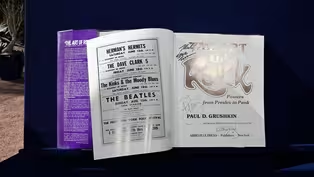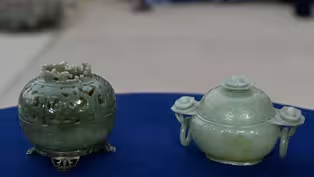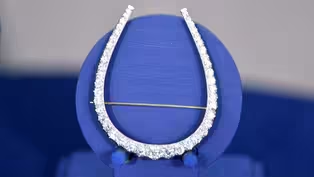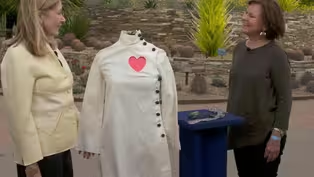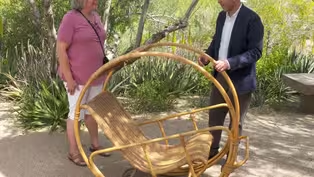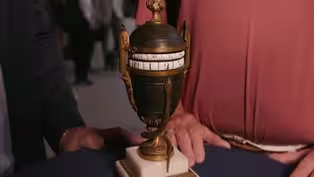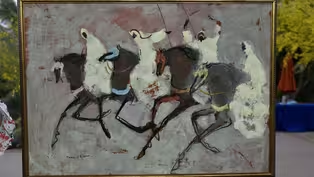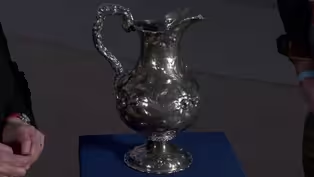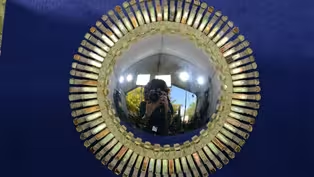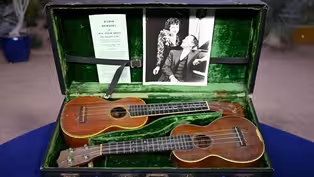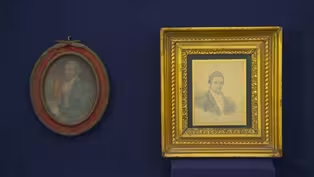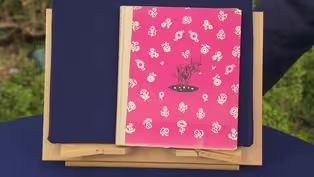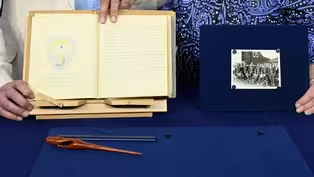

Desert Botanical Garden, Hour 3
Season 24 Episode 12 | 52m 28sVideo has Closed Captions
Phoenix treasures heat up at the Desert Botanical Garden, including a $75,000 appraisal!
Phoenix treasures heat up at the Desert Botanical Garden with a Hassan El Glaoui Tempera painting made around 1970, a Line Vautrin Talosel mirror, and a diamond horseshoe brooch from about 1900. One is appraised for $75,000!
Problems playing video? | Closed Captioning Feedback
Problems playing video? | Closed Captioning Feedback
Funding for ANTIQUES ROADSHOW is provided by Ancestry and American Cruise Lines. Additional funding is provided by public television viewers.

Desert Botanical Garden, Hour 3
Season 24 Episode 12 | 52m 28sVideo has Closed Captions
Phoenix treasures heat up at the Desert Botanical Garden with a Hassan El Glaoui Tempera painting made around 1970, a Line Vautrin Talosel mirror, and a diamond horseshoe brooch from about 1900. One is appraised for $75,000!
Problems playing video? | Closed Captioning Feedback
How to Watch Antiques Roadshow
Antiques Roadshow is available to stream on pbs.org and the free PBS App, available on iPhone, Apple TV, Android TV, Android smartphones, Amazon Fire TV, Amazon Fire Tablet, Roku, Samsung Smart TV, and Vizio.
Buy Now

ANTIQUES ROADSHOW 2025 Tour!
Enter now for a chance to win free tickets to ANTIQUES ROADSHOW's 2025 Tour! Plus, see which cities we're headed to!Providing Support for PBS.org
Learn Moreabout PBS online sponsorship♪ CORAL PEÑA: "Antiques Roadshow" is digging the treasures we're finding at the Desert Botanical Garden in Phoenix.
This is a whole lot of good luck.
(both laughing) It's about the biggest horseshoe brooch I've ever seen.
(laughing): Oh, wow.
♪ PEÑA: It may be a universal truth of collecting.
Collectors want the most variety and the best examples of what's available.
The Desert Botanical Garden's plant collection holds two-thirds of the total number of species in the cactus family.
This includes plants like the icon of the Sonoran Desert, the saguaro cactus.
These giants can reach 50 feet in height, and live for about 200 years.
Guess that makes them antiques.
What centuries-old items have come into "Roadshow" today?
You can bet more than a few.
Let's take a look.
♪ Well, it's a folk art lamp, near as I can tell.
My mother-in-law gave it to us in the early '90s.
She knew we liked unusual things.
(chuckles) These are great ones.
These are, like...
I mean... Yeah, they're the Holy Grail.
I mean, this is it.
This is the... You never see kids' or ladies' spurs.
This is it.
Yeah.
Double-mounted and just really done up.
That's as good as it gets right there.
People would fight over those.
For all of this stuff, you're talking over $10,000 easy in a down market for spurs.
MAN: My maternal grandparents in Liège, Belgium, they owned a shop that sold home furnishings.
Every now and then, they would go down to Paris and go to...
I... they just... What my mom called the market, where they'd look at, you know, people selling different things.
There was, I guess, a lady who sold jewelry and mirrors and stuff.
They liked the mirrors, so they put an order in.
When they received the order, this one, it had, like, a little piece that had been broken off, so they didn't think they could sell it.
So they just kept it at home because they kind of liked the style.
Apparently, they said they sold like hotcakes, and, um, they tried to order some a few months later, but they could never really get in touch with the person again.
So they had one left in the store.
So they took that one, as well.
My parents have that one at their house.
And when my maternal grandmother moved into long-term care, my parents gave this one that was in their house to me.
And do you know who made it?
I'm told somebody named Line Vautrin.
I don't know if I'm pronouncing that right.
So you are, you're doing a great job with the pronunciation.
Her name was Line Vautrin.
And she was a French jewelry maker at first.
She was born in 1913 in Paris into a family of jewelers and metal workers.
And then in 1937, right between the wars, she had an exhibition at the Paris Exposition, offering jewelry.
And she did so well that she got enough money to open up a store in Paris at a slightly more high-end district.
But you have to realize that during this timeframe, you know, then beginning with World War II, precious metals were just not available.
So what she did-- and this is what's so fantastic about this-- is that she turned to other different methods and experimentation of ways to make jewelry and her other real thing that she loved, and her passion was mirrors.
And this is a absolutely magnificent example.
As we can see, it's made of a composite resin, and you can only imagine how difficult it would be, especially with this size, to build up each layer of resin.
They're incredibly fragile, and then to have all these wonderful little mirrored panels around the outside, and then, obviously, this central convex mirror, which is mercury glass.
Do you happen to know when it came into the family, when they acquired it?
Um, she said that they think she got, this one they got in the early '60s, like, '61 to '63.
Okay, and it's most likely that the mirror was actually produced or manufactured right around that time period, shortly before it was then sold.
This wasn't an old thing that was sold.
It could have been Line herself would have been selling this as a new piece at the time, so made around circa 1960.
She was a relative unknown until 1986, when a dealer recognized the importance of her work.
And "Vogue" magazine referred to her as the poetess of metalwork at one point, because she was so magnificent in her jewelry and metalwork, but also this other form, which was this composition that she was using.
Do you have any idea how much they paid for the mirror?
I have no idea.
Any sense of the value?
My mom sent me a picture.
It was hanging above my dog bowl at home, and she sent me a picture of one that was, like, on some website, and they were asking a ridiculous amount for it, like, $30,000 or something.
So I did a little research.
I've seen some as, like, $2,000, and then some seemed to be worth more, but I don't know what makes them worth...
I don't know what the difference is between them.
There seems to be a really big range.
Well, the big difference is, is that the cheap ones are fakes.
Oh!
(laughs) So I am gonna very delicately remove this from the hanging and just turn it around.
And, as you can see, it is actually signed Line Vautrin.
But then, beyond that, what's really great to see is, you can see this really smoky buildup.
Possibly your grandparents were smokers?
I mean...
Yes, my grandfather smoked cigars.
Who wasn't, right?
At some point.
(laughs) The cigar smoke over the years just adhered and sunken into the resin.
And this really reassures us this is in fact a mirror by Line, and not a reproduction.
In 2016, a similar example sold for $27,500.
Since then, there's been considerable interest in her work.
Um, and another example, smaller, sold for $40,000.
So, in getting together with my colleagues, we feel a reasonable auction estimate for this mirror, as a beautiful mirror, would be $40,000 to $60,000.
(laughing): Oh, wow.
That is... that's crazy.
(laughing): I probably shouldn't keep it above the dog bowl anymore.
Probably not.
(laughing) There was one which had more, like, Sputnik-type mirrors.
That one sold within the last couple of years for over $400,000.
Oh, wow.
WOMAN: It's a vacuum cleaner.
My husband works in construction, and years and years ago, he was working on a job for an acquaintance, and he had it in his barn.
And my husband showed major interest in it, and he said, "Well, you can have it," so he brought it home.
So he didn't pay anything for it.
No, uh-uh.
It's awesome.
So it works just by pushing, right?
Yes.
The wheels would turn a crankshaft, and that would then turn a bellows, which would create a suction to the can.
So no electricity required.
It's pretty cool.
Yes.
It's known, was known as a Leasure Vacuum.
Doesn't look too leisure, does it?
I know.
Manufactured in Bradford, PA, right around the turn of the century.
What I love about it is just how crazy it looks, right?
It does.
It looks like it landed from outer space, and really just because it looks cool, you're gonna have people who would just want it as a conversation piece.
Right.
That said, it's got a missing vent here.
Mm-hmm.
Couple of little breaks in the, in the welding there...
Right.
But that's kind of minor.
In this condition, at auction, this would be around $400 to $500.
Oh, really?
Yeah.
That's cool.
I'm glad you brought it, it's pretty exciting to see.
Yeah, well, thank you.
♪ PEÑA: Webster Auditorium is named after one of the garden's earliest champions and benefactors, environmentalist Gertrude Webster.
The pueblo-style structure was the first building on the site, its official dedication taking place on January 21, 1940.
♪ MAN: My mom and dad traveled extensively out of the country, in the country, and they would come back with things they picked up at antique stores.
I think they brought this back from somewhere in their travels in the U.S.
Approximately what period of time?
Probably in the '70s.
Oh, yeah.
In the '80s.
Yeah.
They never really told me what it was.
I was the one that got them, and they've been sitting on a shelf for the last 25, 30 years.
Well, they're both jade.
Okay.
And this one is 18th-19th century, and Chinese.
Oh.
And it's actually mounted by a famous New York jeweler named Edward Farmer.
Oh.
And his mark is on the bottom of it here.
Right.
It doesn't necessarily add to the value, but it ensures its salability.
It's a pomander, for holding spices and things.
Oh, okay.
To make the room fragrant.
And it has archaic scrolling around it.
This one here, on the other hand, is actually most solidly 18th century, and it's what they called Mughal style.
This is Chinese, but carved in an Indian manner.
It was made after jades that were either exported to India or imported from India.
And one of the reasons why you can tell it's an 18th-century one is because it's quite a bit thicker than the later ones.
Hm.
The later ones are carved like a light bulb-- they're very, very thin.
Those yellow spots are referred to as just russet markings.
And those are just in the nature of the jade itself.
Oh, okay.
These jades are notoriously difficult to pin down on a date.
Mm-hmm.
That's why it's 18th-19th century, because one of the things, too, is, these people were carving in the same style over and over and over through centuries, with very little variation.
So this would have been hand, hand-engraved?
All hand-done.
Oh, okay.
Every single thing would be hand-done.
And this...
The, uh, the... Mr. Farmer would have gotten this piece and he would've mounted it out of...
Mounted it, exactly.
Oh, okay.
This one here, with the Farmer name on it, would be probably $6,000 to $8,000.
Mm-hmm.
The other one that's here, the Mughal one, would be more like $8,000 to $12,000.
You're kidding.
(laughs): Unbelievable.
And, and that is at auction.
Right.
That's an auction estimate.
Right, right.
And I would not be surprised if they sold for much more at the end of the day.
Really?
Yeah.
Well, very interesting-- thank you very much.
Wonderful things.
Yeah, thank you.
♪ I brought an etching by Emily Getchell from the 1800s that I got from the family who purchased it from her.
The family, uh, was downsizing, didn't want it anymore, and I got their treasure.
MAN: My friend Jackie Scully, whose art is on this, gave it to me as a thank you.
I'm a personal trainer, gym owner, and natural body builder.
Okay, and as a thank you for your work and your efforts, she gave one of her works to you.
It says one of two here.
Yes.
And he signed it in black Sharpie.
Yes.
Autograph looks great.
Probably projects as a ten, meaning it's as potent as you're gonna get.
And of course, we got a colorful Ali image, as colorful as he was.
It's a great piece.
At auction, you'd probably look at a $300 to $500 price tag for this, a lot of it hinging on Ali's autograph.
Yes.
One of the most desirable ones out there.
Yes.
WOMAN: It belonged to my sister.
She passed away in November 2016.
APPRAISER: I'm so sorry.
And we went down to Houston and cleaned out her house, and I don't even remember where we found it.
I'm sure one of her closets.
And we brought it home, and that's about all I know about it.
Well, it is a most unusual dress from the swinging '60s.
The designer of the dress is a woman named Diana Dew, and she worked with Paraphernalia, which is a major retailing store in America in the '60s.
They had shops in New York and Philadelphia, and up and down the East Coast.
And they were noted for their high-style, contemporary, very current fashion.
And Diana had studied fashion and also studied to be an engineer, and she combined these two things by going into the business of making electric clothing.
So this dress is the first dress I've ever seen that has come with its own cadmium battery pack.
The heart would have lit up.
It lasts as long as five hours in a single wearing.
And it could be set so you get more light, more flashing, more, more intensity.
Uh-huh.
This battery pack was worn on the undergarment that came with the dress, and it would have gone around your waist.
A very clever electrician could probably make it functional again.
Uh-huh.
And you can see that the heart just slips out of the side if you needed to clean the dress.
And the bottom button down here also has its own battery pack, and this button would have spun around in tune to the music and in tune with the heart.
It's just an amazing dress, and apparently she achieved a lot of acclaim for it, and went on to design for different rock bands.
Oh!
And she would get the clothing that, to light up in time with their music.
A retail estimate for something like this, because of its rarity, would be between $2,000 and $2,500 in the current market.
It's just a fantastic piece.
Well, thank you.
♪ MAN: I bought it at an auction... APPRAISER: Yeah?
And they said it was Steuben, but not signed and I said, "I don't think so," but I only...
I didn't pay a lot for it.
Okay, what'd you pay for it?
I think it was $175?
Okay, so...
I, I don't think it's Steuben, either.
So we're both on the same page on that.
In terms of value, I think probably about what you paid for it.
Okay.
Um, as a decorative piece.
WOMAN: I got it from my mother, and, um, she was working during the '40s and '50s, and wore it to work.
APPRAISER: Oh.
What's it made out of?
Copper, I believe.
Yeah, you're right, you're right, it's copper.
Kind of an unusual form.
You know who made it?
Um, I did do a little internet research.
Ah, when, this morning or...?
(laughing): No, when she gave it to me this summer.
Okay, okay.
But I couldn't find anything that gave a value for it.
It's costume jewelry.
Mm-hmm.
He worked in the '50s, '60s, '70s.
So listen, they're actually worth about $50 to $75 today.
Okay, very good.
You know, in the market-- all right?
All right, very good.
WOMAN: What I brought was a diary from my father, who was a prisoner of war during World War II.
Mm-hmm.
He was a member of the Air Corps at that time-- it wasn't the Air Force-- and he flew missions out of England.
He was a navigator on B-17s.
B-17 bomber.
Now, he's in this image right here?
Yes.
In the front row, yes.
Second one, right here?
Yes.
We have his journal here.
We see a lot of World War II journals-- World War I and World War II-- but we don't normally see them as nicely done as this.
The outside of the book is covered with one of his Red Cross packages.
It's the paper... Paper packaging.
Oh, wow.
And if you look inside, you can see part of the label right here.
So the Red Cross packages that he would have gotten his food and other things in were wrapped in this paper, which is kind of neat.
He used it to cover the journal.
On the inside, we're gonna go to a few of the images.
On the inside, we have... this one, which is one of my favorites.
And it's a silkworm and it's in appreciation for basically weaving the silk to make his parachute, which saved his life that day.
Life, yup.
Another one here which is important is, he's, he's mentioning his, basically his first letter home, which he received on February 17, 1945.
Wow.
After being captured since August.
Here we have the date that it was shipped from home, December 19, 1944, and when he actually received it on February 17, 1945.
And in the beginning, this is another interesting one here.
So here we have him as a navigator in his B-17, and... seeing another plane next to him being shot down, and saying, "So long, lads," to his friends in the other plane.
Pretty moving thing.
So it's a little fragile, but we'll get it back up here.
We were able to find some of the missing action reports for your father's plane being shot down.
Yes, very, very good stuff.
(voice trembles): Wow.
And I'm gonna read you a little bit of one of them, and it's describing his plane going down.
It says, "As soon as it started turning, "one parachute came out, but did not open immediately.
"I swung my turret and followed this one down, "and soon after, I was able to count ten open chutes.
"These were floating down very near the target, "and flack was very intense at that point.
"I saw the ship continue to veer to the right for some distance, then I lost sight of it."
So he was a turret gunner in another B-17, and he saw your dad's plane going down.
(softly): Yes.
Wow.
The fact that he survived, where two of his plane mates did not.
Did not.
And he survived prison camp, was pretty, pretty amazing.
So where was the prison camp he was in?
In Barth.
Well, this has two different values.
So we've got the monetary value, which at auction would be in about the $2,000 to $3,000 range.
However, we have another value with it, and that's its historical value.
As far as I'm concerned, its historic value is priceless.
It's just a wonderful journal.
Yup.
Wonderful drawings and a wonderful history in it.
Thanks for bringing it in today.
(voice trembling): Yup, thank you, Dad.
♪ PEÑA: This painting by Scottsdale artist Oscar Strobel depicts an Arizona landscape, a subject that he was known for.
Stylistically, it's different from many of his other naturalistic works, with its flat but colorful illustration of the desert.
Strobel also decorated the upper walls of the main hall with the frieze of Native American figures.
WOMAN: I brought the book "Ferdinand" by Munro Leaf that belonged to my father that he acquired when he was eight years old.
My dad got it in 1937 at a signing.
Uh-huh.
A book signing in Berkeley, California, where Munro Leaf was present.
You are aware that the book was a huge success upon publication, right?
Mm-hmm.
And that is reflected on this page.
The first publication was 1936, and this is the eighth printing, 1937.
What makes this copy incredibly special is the inscription.
Munro Leaf actually made the inscription out to my dad and my uncle, and drew their caricatures, as well as the caricature of the, Ferdinand.
Mm-hmm.
And it's just a sweet little story about Ferdinand the bull, who did not quite fit in with all the other bulls, but would rather be smelling flowers than, than bullfighting.
It came out just months after the Spanish Civil War started, and it takes place in Spain.
That being said, that book was not printed in Spain.
This was considered to be a pacifistic manifesto in a children's book.
And the Nazis and the Franco regime were absolutely opposed against the pacifistic ideas in, in their children's room.
So it was a huge success in the United States, and in some European countries, it was not allowed to be read by children.
When the Nazis lost the war in 1945, the U.S. military distributed 30,000 copies of this book.
Oh, how interesting.
To sort of introduce the deprived kids of Germany... Yeah.
With the idea of a peace-loving, not-into-bullfighting cow.
And in the auction world, even though it is the eighth printing, I would estimate it at about $800 to $1,200.
Oh!
And, um, yeah, I think it's, it's just a truly... Yeah, holy cow!
(both laughing) WOMAN: I found this in a thrift shop in Aurora, Illinois, uh, and I paid three dollars for it.
Well, I can tell you it's from Mexico.
Okay.
And it's 20th century, and it really is quite lovely.
And your three-dollar investment is probably worth more like $20 to $30.
And it's, it always looks good on the kitchen counter.
Thank you so much!
APPRAISER: Everything about this screams '50s.
The dial, the case.
It's a Swiss-made watch, and these little ladies' watches were popular for quite some time.
You tend to see them selling quite often online.
Around $200, $250.
All right, sounds good.
I appreciate it, yeah.
Awesome.
No problem.
MAN: In 1987, when it was published, a friend of mine showed this to me, and I fell in love with the artwork.
It was, I think, $90 at the time, in 1987, and I couldn't afford it, so I found this at a flea market.
What did you pay for it?
$50.
Paul Grushkin is the author of the book.
Yes.
And it's a pretty common book.
But you kind of did something pretty extraordinary with your copy, in that you took it with you to so many concerts, and have 242 signatures in here.
Yes.
I went through the list that you gave me, and the list is long.
Everyone from Willie Nelson to Joan Baez.
We have a giant Steve Miller down here.
I was particularly interested with your Ginger Baker, because he's such a prickly character that he gets a bad reputation.
How was he when you met him?
He was very nice.
We met him at a... At a show in Oakland.
Uh, a jazz club called Yoshi's, and, uh, we got to go backstage for just a few minutes and meet him.
In addition to that, you have Victor Moscoso, Stanley Mouse, Chet Helms-- some of the guys who were really instrumental in creating the artwork of the '60s and the posters that we all know and love from those shows at the Fillmore East, and all over the country.
And Stanley Mouse even added this drawing.
His alter ego.
These artists all charge for their signature now, and he gladly does something like this.
The book itself, it was kind of the seminal work that documented all of the posters of this era.
A copy of this book, a first edition, in great condition, is worth $100 to $150.
Yours is not in great condition.
Something like this-- how did this damage occur?
We met Bo Diddley at a local county fair and, uh, took some things back to have him sign, and he had a bunch of rings on his finger, and the ring cut the book.
So it's celebrity damage.
(chuckling): Yes.
Because of the fact that you have these 242 signatures, plus all of these drawings, and all the stories, because you met some really fantastic people, at auction, I would put an estimate around $2,000 to $3,000 on the book.
Okay.
It was a labor of love.
We took this to every concert we've been to for the last 25 years.
MAN: My grandfather collected it.
He was a collector of fine antiques.
I think it's from France, but I have no idea of the value or anything about it.
We've researched it.
We can't find anything.
It is a French clock.
It was made circa 1890.
And it's called an annular clock.
And it's interesting because it's in the form of an urn.
It was made by the Selsi company in Paris, and they made a number of great clocks.
As you can see, it has this enameled cartouche numerals.
Okay.
And this would be the time ring for the hours right here.
Okay.
And this would be the time ring for the minutes.
And as you wind this clock up, these rotate.
Right.
And the indicator is the tongue of the snake.
Okay.
Which is fantastic.
Very high-quality clock.
It has 13 jewels in it, and it's also signed.
And if I pop the top of the lid off here, the signature is down in here, and it's hard to see.
Oh, yeah, it does.
It does say, "Selsi, Paris."
Okay.
It sits on this marble base.
It has this wonderful patina on it, on these ormolu mounts.
It's all... the gilding's all original.
The condition of it is just exceptional.
It's one of the better ones I've seen.
It is a miniature.
Usually I see them about twice this size.
Okay.
For a retail value, I would say, $2,000.
Wow, that's great.
I appreciate it.
♪ PEÑA: When it comes to vegetation, the Sonoran Desert is the most diverse in all of the North American deserts.
Cactuses... creosote bushes... cholla...
So many incredible plants.
Check out this tall succulent with short, spiky branches.
It's a boojum tree.
Boojum trees can grow over 60 feet tall in the wild and can live for more than 300 years.
♪ I purchased this chair in the late '70s from a store.
I saw it, I liked it.
I've never seen another one since.
The chair has survived moves, kids... APPRAISER: I could see myself as a kid wanting to climb into this chair.
Yes.
Um... And roll in circles, too, I would imagine.
There you go, there you go.
So, do you have any idea how old the chair is itself?
No.
Uh-huh.
I, I thought I was buying it new.
Uh-huh.
In, like, maybe '78, '79?
I'm really not sure what year it was.
Okay.
Would it surprise you to know that it was new probably in 1964?
Yes.
And it was designed by an Italian guy.
His name is Franco Bettonica.
What happened in Italy after World War II is, they took the industrial machine that was making munitions, making war machinery, and they turned it to civilian products.
But the other thing to think about is, it's 1964.
What was going on in popular culture back in the '60s was the space race.
Okay.
It's futuristic.
It's contraption-like.
It really speaks of the Industrial Age.
I think it's really fun to be able to pull all of that off in such earthy materials.
So we have a bamboo frame, and then we have a rattan seat and a rattan canopy.
Do you have any idea what you paid for it back then?
It was around $200.
And has... No more than that.
Have people, or have your kids at some point said to you, "Mom, why don't you get rid of that?"
(laughing): Uh, yes!
"Why don't..." Quite a few times.
That's great.
Today, a chair like this in a gallery setting is probably around $1,500, give or take.
(chuckling) That's great.
They're really rare, so it's hard to really pinpoint an average.
And I wonder if you wouldn't consider sitting in it for us.
Uh, absolutely.
(laughs) There you go.
Yes!
Hey, "Antiques Roadshow"!
This is great!
Comfortable?
Very.
WOMAN: My grandfather was an industrialist in Pittsburgh, Pennsylvania, and he would purchase from auctions and different jewelers in the Pittsburgh area items from estates.
So this pin has been in our family for three generations, and my grandmother used to wear it for fundraisers and different things in Pittsburgh.
There was the Diamond Horseshoe Ball and different things like that.
But... this is the story behind it, that it was purchased from the Lillian Russell estate, who was a opera singer in the 1800s.
Jim Brady had it made for her because they used to ride horses together.
Okay.
That's the story.
These things fall kind of into the category of family lore at a certain point.
And unfortunately, while fascinating and potentially true, without real hard provenance, it doesn't really influence the value of the piece.
You have a picture of your grandmother here, wearing it.
Wearing it, yes.
So the piece dates to the end of the 19th century, right around the turn of the century.
It's a horseshoe.
Horseshoes symbolize luck.
The piece is not signed.
That makes it more likely to be American-made.
It's old European cut diamonds and platinum-topped 14-karat yellow gold.
You can see here that it's yellow gold on the back, but on the front it's platinum.
There are about 15 carats of old European cut diamonds in this piece.
They are about as juicy and lively and beautiful as they can be.
This horseshoe form we see really frequently, but generally quite small.
This is a whole lot of good luck.
(both laugh) It's about the biggest horseshoe brooch I've ever seen, and it's probably the prettiest one I've ever seen, as well.
So do you have an idea when your grandfather would have purchased this in Pittsburgh?
It could have been the 1930s or maybe the '40s.
Do you have any idea what maybe he would have paid for it?
I did find a receipt that, um...
I guess they had to have it appraised for the estate when they passed away.
And so it did say $6,000.
It's just fantastic.
If I were putting this into an auction, I think an auction estimate of $10,000 to $15,000 would be totally appropriate, and I feel it would likely perform at the high end or beyond its estimate.
Good.
This has been in my family for many, many years, before I was born.
APPRAISER: The dress is from the 1920s.
It's made of silk chiffon and then it also is beaded in glass beads.
It is overall just really gorgeous.
Most likely, it was all hand-embroidered in, in France.
Sometimes the panels were actually pre-beaded and then sent to America to put together, because if the gown was made totally in France and sent to America, there would be a higher rate of taxes charged for the dress.
I think it would sell in the neighborhood of $750 to $1,000.
That's very nice.
Thank you.
WOMAN: They came down through my husband's family.
My husband's grandmother was a wealthy woman in Wilmington, Delaware, who was known to collect early American items.
The first one here is signed by the artist.
Hmm.
But we don't know who the sitter is.
It's very, very tiny signature, and it's Thomas Hanford Wentworth, who was an itinerant painter in the 18th century and, and into the early 19th century.
While we don't know the sitter, it's a very fine example of his work.
And on today's auction market, it would be expected to fetch between $500 and $700.
Okay.
Now, the one that's much more interesting is nearest you, and in this case, we don't know the artist.
It was probably an itinerant painter, but on the back of the miniature is an inscription telling us who the sitter is, and the sitter is, goes by the name of William Bayard, Jr. And he was a pretty pivotal figure during the Revolutionary War.
He's best known for being a close friend of Alexander Hamilton's.
And Alexander Hamilton, after his duel with Aaron Burr, died in William Bayard's house in Greenwich Village, New York, and that's where he passed away the day after.
Bayard was a very prominent banker in New York City, and from that likeness and from others like it, we determine that that is probably a portrait taken much later in life.
And it probably dates to about 1810.
Oh!
So it's an oil miniature.
There are very few images of Bayard, except for a handful of other portraits, and this does not appear like those.
So it was probably taken from life.
At auction, the miniature of Bayard, Jr., would be expected to bring in anywhere from $4,000 to $6,000.
Unexpected.
(chuckles) Wow.
It's a fantastic thing.
Thank you.
MAN: This is a book I, I purchased online a few months ago.
Apparently it was published by the Tesuque Pueblo Indian School back in the 1930s.
The teacher and the students put the book together.
The, uh, students drew and colored the maps.
Right.
And, um, they didn't have enough money to publish it, so they used their food money, from what I understand, for the month... Uh-huh.
To buy a mimeograph machine.
Amazing.
And then they printed 30 copies of it to sell for a dollar apiece to pay for the machine.
Incredible.
So it's a book that was produced in 1936 by the third-grade students at the Santa Fe Indian School, at the Tesuque Pueblo, and Mabel Parsons, who is the author here, provided the text... Mm-hmm.
With Anna Nolan Clark, who was another teacher at the school.
And their hope was, as I understand it, to help these students learn English and overcome their fear of books.
Correct.
And they came upon this tremendously interesting idea of having them make a book.
Correct.
And use the text.
Now, as you mentioned, they, um, in the process of creating this book, created mimeographed pages, including a series of ten maps, which the children themselves would hand-color using colored pencil on mimeographed paper.
They would hang the mimeographed sheets to dry out, and what I think is so fascinating about this is, they're using their own knowledge of the geography and where they are to get them interested in reading.
These Native American schools, the Indian schools, were very controversial-- are controversial-- for trying to indoctrinate these children into Western ways and give up their Native American heritage.
But at least in this instance, there was some effort to approach them with a sensitivity to the geography and their place of home-- at least develop an interest in education from a Western perspective that was at least somewhat sensitive to their homes and tradition.
So you have things like this map, this, this rose compass that would be on a map, and it has a Zuni symbol on it.
It's really phenomenally interesting.
We'll look at another map in here that they created, and it has a similar layout, with lots of hand illustrations by the children.
It's really an unusual object.
I don't know... You mentioned that there were 30 copies made.
That's what I understand.
There was an article written about this book recently in, in a Santa Fe newspaper, right?
Correct.
It's an extraordinarily rare object.
You kind of stumped us a little bit, because we normally, when we try to evaluate something, have comparables-- other objects similar to it-- even if we don't have the same edition.
Right.
The truth is that there really have been no copies of this book sold, at least at auction, in as far back as I can see.
But even in the context of, you know, frontier literature, you might have a small printing press on, on the frontier, in Wyoming and so forth.
But that would be run and managed by, obviously, Western settlers.
This is a book printed on the Tesuque Pueblo in 1936 by children in the third grade.
And I can't think of another example like it.
Yeah.
It's really an amazing thing.
Pretty amazing.
So will you please tell me possibly what you paid for the book, and possibly why you bought the book in the first place?
Yeah, I paid about $300 for it.
All right.
Which, for me, was a lot to spend on a book.
Yeah.
But, uh, I'm an archaeologist.
I like history.
Uh, my mom used to work with the pueblos heading up Head Start programs.
Oh, right-- amazing.
So it had that kind of a connection that just kind of spoke to me.
There has been at least one copy that might have been offered by a private dealer in recent years, but that appeared to have been incompleted-- probably only had five maps, according to what I understand.
In a situation like this, I would say, for valuation purposes, we would want to be conservative and to see how much interest institutions and others would have in it.
But in an auction context, I would say it'd probably have an estimate of $3,000 to $5,000.
Oh, wow.
We know that nine institutions had one, leaving about 20 in private circulation.
Yeah.
♪ It's by Carl Sorensen.
WOMAN: Okay.
Quite well-known designer, and produced pieces in this, in this style, with sort of oxidized copperish sort of design on them.
These pieces are quite typical of his work, but this one is a little bit more unusual, because you've got this sort of stylized bird motif on the top.
His pieces are pretty well sought-after.
We have the whole dining set.
Wow, that's great, including the original receipt.
And the original receipt.
Yeah.
Absolutely classic Limbert Arts & Crafts piece.
It's just so great.
Serving table.
$30 in 1915.
(man chuckles) Serving table in 2019 at auction, $1,500 or $2,000.
We like it.
I don't blame you!
(laughing) WOMAN: My grandfather bought it in Wewoka, Oklahoma, from his doctor.
And then when he passed away, in 1968, my grandmother wanted to throw the painting away, and my mother said, "No, I want to keep it."
And so she did.
And six years ago, then, she gave it to me.
I did have it restored and then properly framed.
I think I spent about $3,000, $3,500.
So you invested some money in this.
Yes, I have.
And why did you do that?
Because I did an online search for the artist and about had a heart attack when I realized that this was a painting of, of some significance, both historically and artistically.
What did you find out?
That the artist, Ernest Spybuck, was a Shawnee Native American from Oklahoma, and that his works of art were in museums around the country.
I love Ernest Spybuck.
He wasn't a trained artist, but he had a way of capturing life around him.
Now, do you know the title on this by heart?
No, I don't.
So I would have to read it from the bottom.
(chuckling): Right.
It says, "Wild Ride, Green Corn Dance, Kickapoo Indians and Shawnee," and it's signed by Spybuck.
They would gather to celebrate that the corn was green, that green was edible for them.
So it was a gathering of celebration.
The painting is mixed-media-- there's pencil, watercolor... Mm-hmm.
Maybe a little ink.
He was just amazing in his ability to paint what he saw.
His documentation of daily life are just treasured.
There are works in the Smithsonian.
He was commissioned to do some murals for the government in different buildings, mostly in Oklahoma.
He was born in 1883 and died in 1949.
I was wondering about what year you thought that this might have been painted.
Around the 1920s.
There's a fair amount of his works around, but you rarely see him coming to market, and if you were to offer this piece at auction today, it would sell for about $35,000.
Oh, my.
That's much more than what I expected to hear.
So...
It's so lively and so beautiful.
Well, thank you so very much for this.
♪ PEÑA: This gray-green barrel cactus is called Nichol's Turk's head cactus, a plant native to Arizona.
It's also on the endangered species list due to the spread of invasive species, the mining of minerals, and the use of recreational off-road vehicles in its mountainous home terrain.
♪ APPRAISER: Well, this is a couple of firsts when you walked up with this case, because I'd never seen a double ukulele case before.
MAN: Okay.
But when I opened it, what caught my eye was the, was the photo on the lid.
That is my great-grandmother, May Singhi Breen, and her husband, Peter De Rose.
So they were passed down through our family.
And I, I got these about ten years ago.
And so can you tell us anything about the man in the picture?
Sure, so that is Peter De Rose.
He was a very well-known composer at the time.
He was also, along with May, in Paul Whiteman's orchestra, and they were known as "The Sweethearts of the Air" on CBS Radio in New York for 25 years.
Right.
And he wrote "Deep Purple" and "Wagon Wheels" and "Have You Ever Been Lonely?
", and quite a few fairly well-known songs for their day.
Yeah, a few.
Yeah, so, he played piano and she played ukulele.
May Singhi Breen is a superstar in the ukulele world.
She was the first woman inducted into the Ukulele Hall of Fame.
She was also instrumental in getting the ukulele accepted by the American Federation of Musicians union as a real musical instrument.
Before that, the ukulele was just a novelty.
So if you were a ukulele player, you had... You basically had no cred at all among musicians.
So you were just, like, "Oh, yeah, that thing."
Gotcha.
And she did arrangements for hundreds and hundreds of songs for the ukulele.
She was instrumental in using the ukulele for teaching kids in schools.
So she was a really big deal.
And she loved Martin ukuleles, and they made her a number of custom ukuleles.
And this is, is one of the... of the highest model, the 5K-- the K stood for koa.
So it's figured koa.
Okay.
What makes this one so special is the name "Ukulele Lady," and she was billed as the Original Ukulele Lady, and then her name on the headstock.
It's a pretty special uke in, in several ways.
There's a similar one in the Ukulele Hall of Fame.
Okay.
And this is a, a more typical model.
It's a 3M-- that would be one model down.
There wasn't a, there wasn't a four.
The fancier ukulele is, is from the mid-1930s.
Okay.
1934, '35.
This one's quite a bit earlier.
It has a number of features which peg it to probably 1926, '27.
They're both the soprano style, which is the original ukulele.
A 5K Hawaiian ukulele, without any association with May Singhi Breen, is currently in the $7,500 kind of price range.
Okay.
And a 3M, this is earlier and pretty nice, so that's probably in the $1,500 range.
Okay.
But when you put the two together, and then the double case, and the whole association with her, and the photos, takes it up to a much higher level.
In a vintage shop, we're probably looking at a, at a retail value of about $15,000.
Okay, great.
MAN: So my great-great-grandfather was emissary to China.
The United States didn't have an ambassador to China at that time.
APPRAISER: What year?
Like 1890s.
Okay.
So, so he was the major U.S. representative to China from the U.S. And where was he stationed?
You know, that's a really good question.
I don't know the answer to that.
Okay.
Yeah.
And you... but he brought this back.
We believe it must have been.
A lot of official buildings would have ridge tiles.
This is a ridge tile.
So it's the top of the building.
And you can see it was actually meant to be used, because it has this fitted section at the end that would lock on to the adjoining tile.
So this was the end tile on the ridge of a roof, and it was protective.
So part of the protective quality, of course, was the glaze, and the tile stopped fires.
And at the top, you would have one of the animals of the Zodiac, or various other kind of protective animals or figures.
And stylistically, this is the kind of thing that would date to the early Qing dynasty or late Ming Dynasty.
So 16th, 17th century, early 18th century.
It's a nice example, but it does have condition issues.
It does, yeah.
You know, there's always gotta be one that's in better shape.
(chuckles) So... Now, is it a phoenix?
Well, it's got a truncated tail.
Usually, a phoenix with long tails.
But this is certainly the head of a phoenix, yes, so... All right.
And estimate, I would recommend somewhere in the $700 to $1,000 range for insurance purposes.
♪ WOMAN: It's a powder horn, and my daughter got it from the Ukraine.
A man who sold it to her said it was his great-grandfather's from the revolutionary war of the Ukraine.
So that's what we're thinking.
Maybe 1800s?
Right there... We pull out that little lever.
Uh-huh.
And your hands move.
Oh!
That's how you set your hands.
Oh!
This one dates from around 1895 to 1900.
Okay.
And when we look at the dial, we see it says "United States Watch Company" on it.
That was a company...
Okay.
That was in business for a short period of time.
And they were large manufacturers, large producers of pocket watches for both men and women.
This is a classic lady's size watch.
In today's market, they would probably ask about $400 to $500 for this one.
Okay.
MAN: It was handed to my mother from her mother.
And it came from one of her relatives that was a yachtsman, and he won it in a race in, uh, the Gulf of Mexico, I guess it was.
They're from Biloxi, Mississippi, and she gave it to us.
And we put it on the shelf, and that's about all I know about it.
Right.
Do you know where it's from, where it was made?
Um, I don't, I don't know where it was.
Okay, well, it was made in New Orleans, in Louisiana.
So the mark is on the base here.
It's marked for Hyde & Goodrich, which were a retailer in New Orleans, sort of similar to Tiffany in New York.
They were sort of the big name.
And what's interesting, there's another mark on here.
There's an H, and the H actually stands for the, the name of the person who actually did the silversmithing.
Mm-hmm.
So Adolphe Himmel, who was a German immigrant, who came into New Orleans in the 19th century.
And this piece is probably 1850s, pre-Civil War South.
New Orleans is a very large, important city on the Mississippi.
It's got, um, trade, and there's a lot of money there.
And so people were buying these sort of rich and ornate silver items.
It's a water pitcher, a form very typical of the time and place.
This fantastic handle looks like a branch that has just been fashioned.
Mm-hmm.
And there's a lot of greenery and flowers decorating it.
Pretty impressive piece for New Orleans in the 1850s.
For insurance purposes, I think you want to think about a figure at around $10,000.
Whoa, are you kidding me?
I'm not.
Oh, my goodness.
Is it solid silver?
It is solid silver.
Wow.
Southern silver, very popular.
Um, not a lot of it, great design, great style.
That's a real surprise.
WOMAN: I brought a painting from Morocco from the artist Hassan El Glaoui, and it was gifted to my father in 1971.
My father was in the mining business and worked for a company that made big mining machinery.
Mm-hmm.
So he was invited to Morocco by King Hassan, and he took him as a gift one of the very first digital watches that had ever come onto the market.
And the king was thrilled, and he said, "I'd like to give you a gift."
So he sent him with a driver to the home of his favorite artist.
The artist wasn't there, but his wife was.
She took him into the studio where there were maybe a hundred paintings, and said, "Take your time."
And most of the paintings were bright red, and orange, and turquoise.
And so he was looking for something a little subtler, and this is the one he chose.
At least one, maybe more, of my siblings said, "Dad!
Oh, yuck!"
(laughs) So he took it and put it in his office, and he kept it there till he retired.
He kept it in a house that had no heating, no cooling, right near the ocean, and you can see little drips.
It depicts a succession of horses in the Moroccan tradition, with the riders raising their weapons up in the air.
And this is one of El Glaoui's favorite themes and subjects for his paintings.
The medium is tempera on board, and as you can see, it's quite a large painting, and it's signed here in lower left.
Hassan El Glaoui was born into one of the most wealthy families in Morocco, and it was a 300-year dynasty.
His father, Thami El Glaoui, basically, today, would have been considered one of the richest men in the world.
Oh.
His father was a good friend with Winston Churchill, so Churchill visited his father in 1943.
And Churchill was actually a painter himself.
Now, while Hassan El Glaoui's father wanted him to be, follow in his footsteps, or be more of an administrator, in an administrative role, the son wanted to paint.
And actually, Churchill was the instrumental person in his life who told him, "You can be both a painter and an administrator," if you will.
Following Churchill's advice, El Glaoui went to Paris, and he exhibited at some of the most important galleries in Paris and then ended up returning to Morocco in 1965.
You said your father was there... 1971.
1971.
Basically, we can date this painting to around that time period, some time between 1965 and 1971.
The artist just passed away, unfortunately, last year.
Yeah.
He was 93 years old when he died.
There's a lot of interest in his work.
The painting is overall in good condition.
The value of this painting, for insurance purposes, I would put at $75,000.
Oh, my.
(laughing): Oh, my.
I knew it was worth something, but not... With the water damage, I... That's... that's, um... (laughing): Pretty amazing.
I think a qualified conservator could take care of this kind of restoration.
I do think it will increase the value, especially if you do take care of some of the, uh, losses, as well.
And it could be actually closer to about $85,000 to $95,000.
As an insurance value.
Whoa.
(laughs) PEÑA: You're watching "Antiques Roadshow" PEÑA: And now it's time for the "Roadshow" Feedback Booth.
I found out today that there were some, uh, inventive folks in Ames, Iowa, back in the '70s who were creating some fake Handel lamps.
And guess what we got here.
It's a fake Handel, but it's still beautiful.
So, thanks, "Antiques Roadshow."
I got it, um, years ago at, uh, just a flea market.
I can't even remember what we paid for it, and I, and, uh, it's worth between $400 and $500.
And when the guy told us, he sounded apologetic, and I'm thinking, "That is a fortune."
So I'm thrilled!
(laughs) We have a Noah's Ark, and it's, uh, by a famous Mexican artist named Sergio Bustamante, and he's traditionally known for more avant-garde, uh, working with resin.
But this is a ceramic, and it's a one-of-a-kind piece, and, um, you know, they told us it's worth between $3,000 to $5,000.
What I have here we thought was a slip to these Victorian dresses we brought.
And it ended up, we just learned, that it is a dress by itself from the 1930s that you just slip over a slip.
And so we were quite, quite amazed.
So that was a big learning curve for us.
This is our snake charmer flute.
And this is what we kept the snake in, but...
He's around here somewhere.
PEÑA: Thanks for watching.
See you next time on "Antiques Roadshow."
Appraisal: Autographed "The Art of Rock" Book
Video has Closed Captions
Clip: S24 Ep12 | 2m 20s | Appraisal: Autographed "The Art of Rock" Book (2m 20s)
Appraisal: Chinese Jade Pomander & Censer
Video has Closed Captions
Clip: S24 Ep12 | 2m 27s | Appraisal: Chinese Jade Pomander & Censer (2m 27s)
Appraisal: Diamond Horseshoe Brooch
Video has Closed Captions
Clip: S24 Ep12 | 2m 42s | Appraisal: Diamond Horseshoe Brooch (2m 42s)
Appraisal: Diana Dew Light-Up Dress, ca. 1965
Video has Closed Captions
Clip: S24 Ep12 | 2m 19s | Appraisal: Diana Dew Light-Up Dress, ca. 1965 (2m 19s)
Appraisal: Franco Bettonica Rocking Chair
Video has Closed Captions
Clip: S24 Ep12 | 1m 54s | Appraisal: Franco Bettonica Rocking Chair (1m 54s)
Appraisal: French Annular Clock
Video has Closed Captions
Clip: S24 Ep12 | 1m 31s | Appraisal: French Annular Clock (1m 31s)
Appraisal: Hassan El Glaoui Tempera Painting
Video has Closed Captions
Clip: S24 Ep12 | 3m 43s | Appraisal: Hassan El Glaoui Tempera Painting (3m 43s)
Appraisal: Hyde & Goodrich Silver Water Pitcher
Video has Closed Captions
Clip: S24 Ep12 | 1m 43s | Appraisal: Hyde & Goodrich Silver Water Pitcher (1m 43s)
Appraisal: Line Vautrin Talosel Mirror, ca. 1960
Video has Closed Captions
Clip: S24 Ep12 | 4m 26s | Appraisal: Line Vautrin Talosel Mirror, ca. 1960 (4m 26s)
Appraisal: May Singhi Breen Ukuleles
Video has Closed Captions
Clip: S24 Ep12 | 3m 7s | Appraisal: May Singhi Breen Ukuleles (3m 7s)
Appraisal: Miniature Folk Portraits, ca.1810
Video has Closed Captions
Clip: S24 Ep12 | 2m 14s | Appraisal: Miniature Folk Portraits, ca.1810 (2m 14s)
Appraisal: "The Story of Ferdinand" 1937
Video has Closed Captions
Clip: S24 Ep12 | 2m 10s | Appraisal: "The Story of Ferdinand" 1937 (2m 10s)
Appraisal: WWII Journal and photo
Video has Closed Captions
Clip: S24 Ep12 | 3m 20s | Appraisal: WWII Journal + photo (3m 20s)
Providing Support for PBS.org
Learn Moreabout PBS online sponsorshipSupport for PBS provided by:
Funding for ANTIQUES ROADSHOW is provided by Ancestry and American Cruise Lines. Additional funding is provided by public television viewers.


